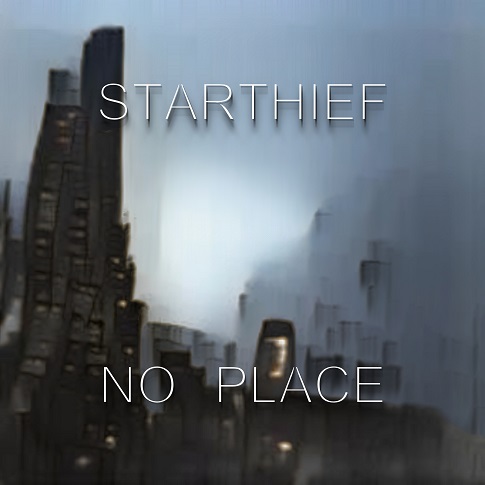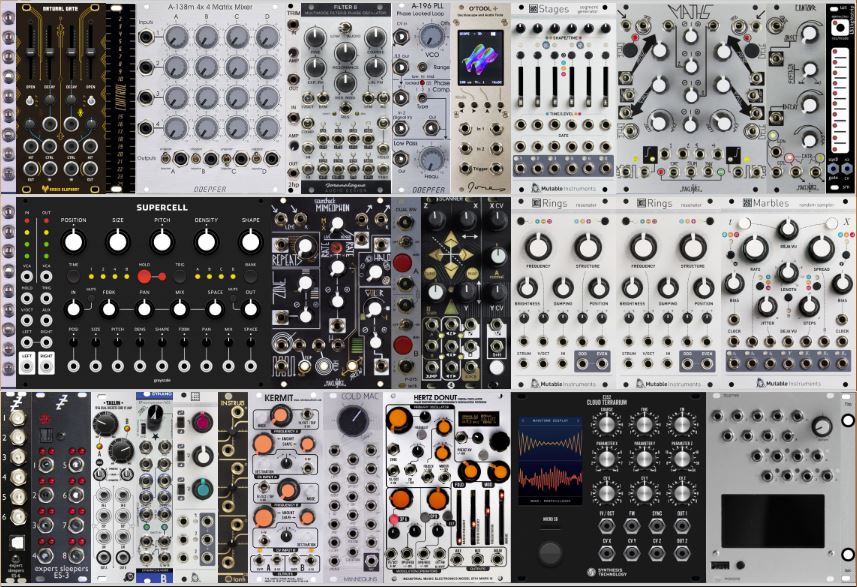
The subject matter of my music is so often not a story, but a scene — a place, its weather, context and situation, and the feelings and memories they evoke. Many of these have been inspired by actual locations; some are less specific but are typical scenes that are familiar to everyone.
This album, though, is a tour of some of the secret and private environments of my imagination, with no physical address in space, no particular location in time.
I’ll lead you to a magical behind-the-scenes realm of childhood imagination. We’ll hang out in a metaphorical parking lot, neutral territory for meetings with gods and spirits. Visit a fictional setting more prominent in my memory than the placeholder characters and tenuous plot points that inhabited it. We’ll cautiously investigate the towers and bridges of recurring nightmares that still haunt me.
The album art was created with Runway Generative Engine, and enhanced and edited using Gravit Designer Pro and Paint Shop Pro Ultimate 2020.
Equipment & Process
Here’s a ModularGrid representation of the Eurorack modular system I used to record the majority of this album:

From top left: Bastl Multiple, Rabid Elephant Natural Gate, (4 HP blank), Doepfer A-138m Matrix Mixer, 2hp Trim, Joranalogue Filter 8, Doepfer A-196 PLL, Dave Jones O’Tool+, Mutable Instruments Stages, Make Noise Maths, Make Noise Contour, Soundmachines LS-1 Lightstrip.
Second row: Bastl Multiple, Grayscale Supercell (a version of Mutable Instruments Clouds), Make Noise Mimeophon, Ladik P-075 Switches, Starling Via Scanner, Mutable Instruments Rings (x2), Mutable Instruments Marbles.
Third row: Expert Sleepers ES-6 & ES-3, Xaoc Tallin, Mutable Instruments Shades, Instruō tanh[3], Industrial Music Electronics Kermit, Mannequins Cold Mac, Industrial Music Electronics Hertz Donut mk3, Synthesis Technology E-352 Cloud Terrarium, Monome Teletype, bpcMusic TXb.
Not shown: ADDAC201 Pedal Integrator, Circuit Abbey Gozinta, Mutable Instruments Ripples.
The patch notes below do not always name utility modules and specific modulation sources.
Also used: Yamaha Reface CS through Elektron Analog Drive, Arturia Microbrute, Chase Bliss Dark World pedal, Behringer UMC1820 audio interface, 16n Faderbank controller, Korg SQ-1 sequencer.
The DAW was Bitwig Studio 3 (except for “Between”, which used Native Instruments Maschine). With Bitwig and the Expert Sleepers modules, hardware and software weave into a unified modular music system.
Each piece was recorded in real time, in a single take, as a full mix. There was no linear sequencing, clip launching, or multitracking.
Sequencing in the DAW was restricted to a few simple loops. All other programmed sequences were done with the SQ-1, Stages or Teletype; generative and algorithmic sequencing was done mainly with Teletype, Marbles and Bitwig; other parts were played live via keyboard or allowed to drone. Control over mix levels, timbral parameters and some logical switching was via the 16n Faderbank and Ladik manual switches.
Recordings were edited and mastered in Sound Forge Pro 13.
VST plugins used throughout the album and not mentioned in the song notes below included HASound MSLR, Izotope RX6 Declick, Native Instruments Transient Master, Toneboosters EQ 4 and Barricade 4, and u-he Presswerk.
I used a few of my own experimental VST plugins:
- ByteBeater is an instrument/sound source inspired by “bytebeat” aka “Music From Very Short Programs”. My implementation is concerned specifically with oscillation and noise rather than full musical sequences.
- Crumble is a downsampler with interpolation.
- Shameless is a blended parallel set of digital distortion methods using Boolean logic.
- Binscreen uses a phase vocoder to separate audio into frequency bands, and then discards an evenly spread portion of those bands to thin out the frequency spectrum.
- Elitist is similar, but discards all but a very few strongest frequency bands at any given moment. It can also apply a decay time to each band to overlap them, smooth out changes, and extend transients.
01: Between
This is a prelude rather than a part of the album proper. Recorded during the mastering phase for the previous album, I knew changes were coming, but I hadn’t finalized them yet, nor decided on the album theme. This was recorded using NI Maschine as the DAW.
The main voice is the E352 in Cloud mode, FMing itself, through tanh[3] and Supercell in pitch/stretch mode, with u-he Colour Copy and Runciter, and Valhalla Vintage Verb (“VVV”). The voice is sequenced by Marbles.
Additional drone voices are from Reface CS/Analog Drive, and two instances of ByteBeater with Valhalla Room.
02: No Place
The main voice is Mimeophon in self-oscillation, with its Flip modulated at audio rate by Kermit. Through Crumble, u-he Twangström, AudioThing Speaker, and Arturia Delay Tape E-201. Played via keyboard.
Background drone is from E352 and Hertz Donut mk3 merged in Scanner, with Bitwig Frequency Shifter, Shameless, ColourCopy, and Valhalla Plate.
There’s also a timestretched recording of a hair dryer through Arturia Delay Eternity.
VVV, Valhalla Plate, Melda MTransformer, Elitist, and Binscreen were used on the full mix.
03: TBM
The main voice is Hertz Donut mk3 through Tallin, with envelopes from Stages, through Mimeophon, VVV and Arturia Delay Eternity. It’s playing a generative sequence that comes from quantizing a Kermit LFO in Bitwig Grid, with the clocking under semi-manual control — moving a slider on the 16n Faderbank squeezed notes out of it as if from an eyedropper.
The background drone is E352 in cloud mode, with both outputs into Scanner, and the E352’s morph modulated by Scanner’s logic output. Through Natural Gate, Bitwig pitch shifters in mid-side configuration, and Psychic Modulation Echomelt.
Noise is from one of my old recordings called “bus” (probably a vehicle, but maybe something that only sounded like one?) with its amplitude modulated by white noise, through Arturia Delay Tape-201 and Audiothing Megaphone.
The full mix was treated with Klevgrand DAW LP and Haaze.
04: Radio Avalon
The main voice is a complex stereo feedback loop with two Rings in “Western Chords” mode, Mimeophon and Scanner. It’s playing slewed sequences from Teletype and Marbles, and several parameters are modulated by Kermit. With NI Transient Master, Audiothing Fog Convolver, and Arturia Delay Memory-Brigade.
In the background there’s D16 LuSH-101 through D16 Decimort 2, Valhalla Delay, and Bitwig’s Blur effect.
The full mix is processed with Klevgrand Brusfri, Valhalla Plate, and a lot of EQ to tame strong resonances and reduce harshness.
05: Mid-Sky
The first drone in this piece is an 8-part harmonic oscillator in Bitwig Grid, modulated by the E52, with a Chebyshev wavefolder. This runs through Dark World with a feedback loop around it. The harmonics, modulation and fold amount are all controlled via 16n Faderbank.
An additional drone is provided by the Microbrute, with its filter and pitch FMd by Kermit. This runs through Valhalla Plate, a Bitwig filter, and XLN Audio RC-20 Retro Color.
Rings in modal mode, Scanner, Supercell in Clouds mode, and Mimeophon, feeding back to both Scanner and Rings’ input, is sequenced by a Korg SQ-1 and processed by RC-20.
There’s some wind noise from cold_stormy_wind.mp3 by Blastwave FX.
Native Instruments Una Corda through Fog Convolver is used for one single note.
The full mix was processed with Melda MCharacter and VVV.
06: Cryptomechanica
The main drone source is Bitwig’s FM-4 instrument, modulated by several unsynchronized LFOs. The first “voice” runs through Mimeophon (modulated by Kermit); the left and right channels go through Filter 8 and Ripples as highpass filters. This is mixed with Bitwig’s Sallen-Key lowpass, and the result goes through Valhalla Delay.
The second “voice” is Kermit AMing the FM-4 output, through Bitwig’s pitch shifter and Valhalla Plate.
Another drone is provided by Hertz Donut mk3’s two outputs cross-panned in Cold Mac. The crossed signals feed E352’s FM and phase modulation inputs; E352 is set to LFO rates and strong linear FM.
Maths oscillates at audio rate, through Tallin, Supercell in Spectral Madness mode, Colour Copy and RC-20. Stages provides the sequence, clocked by the E352’s slow carrier signal with the audio rate information filtered out.
07: Borealis
Voice 1 is Hertz Donut mk3, with Op B modulating the main osc and Op A in stereo, through Natural Gate and Supercell delay.
Voice 2 is E352 in 2-Op FM mode, through Rings.
Voice 3 is Microbrute, with Shaperbox2 warbling the pitch, and Delay Eternity and RC-20.
Valhalla Delay and Valhalla Plate are on each voice, and the full mix is processed in Melda MCharacter, Elitist, and Transient Master.
08: Grotto
Reface CS/Analog Drive, with the output feeding a PLL and envelope follower. These drive Maths, into Cold Mac, Scanner, then both Rings in modal mode. With Sonic Charge Echobode, Bitwig frequency shifter, ToneBoosters Reverb 4 and RC-20. The sequence comes from Bitwig note latch and arpeggiator.
Post-processed with more RC_20, Elitist, Valhalla Room and Haaze.
09: Einstürzende Alte Brücken
The beginning noise/hum is a field recording from the Detunized “Around Bridges” sample pack.
Creaking noises and “cable twang” are from Mimeophon self-oscillation which was then frozen; it’s modulated by Kermit which is synced to Mimeophon’s pulse output. Through Delay Eternity, Sonic Charge Permut8, and Fog Convolver.
More wind and expansion gap ambiance from “Around Bridges”, in Bitwig Sampler with sample position driven by a pair of LFOs, through Toneboosters EQ and VVV.
The descending pitch sequence is E352 in 2-Op FM mode, with the ratio, index and morph modulated by Stage LFOs. Crosspanned in Cold Mac, through Supercell clouds trigered by a Kermit LFO creating the stuttering pulses. Processed in Haaze.
Ringing tones are Maths envelopes through Scanner, exciting Rings in sympathetic string mode, and Scanner’s logic output into Rings #2 in Karplusverb mode. Both are processed through Audio Damage Ratshack Reverb and RC-20. Maths is triggered by rhythmic pulses from Teletype.
10: Nomads
All of the foreground and background plucks and percussion at the start are Supercell in resonator mode, with Mimeophon. Teletype and SQ-1 sequence the pitch, chord setting and delay parameters.
The bass part that joins in after two and a half minutes is Kermit through Natural Gate, through Denise Bad Tape and Valhalla Delay. Sequencing is Teletype and Shades.
Sustained pads are Kermit’s second VCO, tracking the first in PLL mode, through Natural Gate under manual control. It shares effects with the bass part; a second layer uses Rings as a lo-fi reverb.
Post-processed with MCharacter and Fog Convolver.
